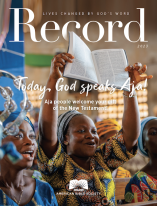How to Increase Retention in Bible Reading
Apply participatory learning techniques to Scripture engagement
How do you learn? Do you write new information down, discuss it with a friend, diagram it, or need to listen to it before it really sinks in? Or do you engage in learning in a different way entirely?
I love this commonly quoted saying: “Tell me, I’ll forget. Show me, I may remember. But involve me, and I’ll understand.” It has been variously attributed to Ben Franklin, Confucius, or just a “Chinese proverb.” Whoever made this up, it succinctly states a key educational concept: Invovement stimulates understanding.
In my experience of teaching the Bible, the Involvement Principle has proven true time and time again. It’s spelled out even further in another bit of folk wisdom called the Learning Pyramid, which estimates knowledge-retention rates among learners.
- Some information is retained through lecture.
- More of the information was retained through reading.
- Even more through audio/visual presentation.
- Still more when someone demonstrated the material to them.
- More when they were able to discuss the material with others.
- More when they were able to practice what they were learning.
- And the most when they were asked to teach others what they had just learned.
Trying More Active Teaching Methods
While this recognition has revolutionized how I’ve approached my preparation and delivery of Scripture, it has also humbled me. In years past, I taught almost entirely with passive teaching methods (lecture, reading, audio-visual). I would thoroughly prepare to teach the Bible and then lecture to people for 30 minutes while they listened quietly—and then I would get frustrated when I discovered they couldn’t remember the content shortly after I had presented it. Sadly, I blamed them for much of the lack of retention. It wasn’t until later I realized that much of the blame needed to be laid at my own feet.
Then I began to apply the pyramid to my preparation and delivery in teaching the Bible. I’ve put into practice more active teaching methods (discussion groups, practicing by doing, and then having learners teach others). As a result, people have begun to engage more fully with the material. Groups are remembering the Bible passages weeks later. Individuals are excited to come back and learn more. I even began hearing of people telling other people what they were learning in our Bible study group months later.
Learning From Jesus’s Teaching Model
The pyramid has also helped me to recognize the ways Jesus taught—and how he used these methods for lasting impact and transformation in people’s lives.
- Jesus lectured. The Sermon on the Mount being his longest and most memorable teaching.
- Jesus read the Torah in the synagogue. He regularly asked the religious leaders the rhetorical question, “Have you not read …?” This is a question asked almost more than any other in the Gospels.
- Jesus used vivid word images. He told everyday stories to explain the kingdom of God (fish, coins, a net, a woman kneading dough).
- Jesus demonstrated his teachings often. He held a coin as he talked about responsibility to government and to God. He put a child in the center of a group of feuding disciples and talked about humility. A number of his miracles were connected to specific teaching points.
- Jesus engaged in discussion. He often asked incisive questions to spark conversations (even controversial ones) with others. For example, he asked scholars for their opinion about a Messianic prophecy from the Psalms. On another occasion, he polled his disciples to see who people thought he was.
- Jesus practiced by doing. He demonstrated love through compassion and healings. He didn’t just tell his disciples to serve others; he got down, got a servant’s basin and towel, and washed his disciples’ feet.
- And lastly, Jesus taught his disciples and then told them to go teach others. He sent his disciples out to teach and do everything they saw Jesus doing. Jesus knew that the best way you learn is to teach others.
Teaching in a Small Group
Here are some ideas for how you might teach a passage of Scripture:
- Lecture. You probably already do this, so there’s little need to say more.
- Reading. You could read the passage, but maybe have others read the passage. Read the passage in different translations (or even different languages). Consider doing a dramatic reading or a responsive reading. Put the passage up on a screen and invite people to sit in silence and read the passage slowly and repeatedly.
- Audio-visual: Consider showing artwork that relates to the passage and display it on the screen, print in the bulletin, or hang it around the room. (For a great source of biblical art check out https://www.artbible.info). Could you ask the artists in your community to create pieces relating to the passage? Or, you could hand out paper, colored pencils, or crayons and have them draw the passage themselves. You could play a song that was written with that particular passage in mind.
- Demonstration: Invite others to act out the passage (not just children—this is great for adults, too!). Could you simulate a conversation of how someone would flesh out the story or concept from Scripture? Interview someone who has lived out the truth of the passage in their own lives.
- Discussion Group: This is a common practice in small-group sessions, but consider how it might enliven a Bible class you’re teaching, or even a sermon.
- Practice by Doing: Consider ending the time together by asking people to share the one thing they will do with the passage in the next seven days—and tell the person next to them (or the entire group). Instead of teaching on prayer for 30 minutes, could you teach on prayer for ten minutes and spend the remaining 20 minutes actually praying together?
- Teaching Others: Ask a volunteer to come forward and summarize what we just taught. Or, better yet, ask someone to come back next week and share a summary of the teaching—or even ask someone to co-teach with you next time.
The options and opportunities are endless when it comes to teaching the Bible. The challenge for teachers of the Bible is to continue to push down for deeper engagement and retention when teaching God’s Word.

J.R. Briggs
J.R. Briggs started Kairos Partnerships in 2011 where his role is expressed through coaching, consulting, speaking, teaching, equipping and writing to serve a wide variety of leaders, pastors, churches, non-profits, ministries, companies and denominations. Over the past several years, he has invested in kingdom leaders in over 23 states from over 40 different denominations. In addition to starting Kairos Partnerships, he planted The Renew Community, received a master’s degree in Missional Theology at Biblical Theological Seminary, and is currently working on a Doctor of Ministry degree at Biblical. His doctoral thesis focuses on how question-asking in leadership can advance God’s mission. He is an author, co-author and contributed to nine books that seek to equip and care for kingdom leaders. J.R. and his wife Megan have been married for over 16 years and have two sons, Carter and Bennett.
Thanks to the support of our faithful financial partners, American Bible Society has been engaging people with the life-changing message of God’s Word for more than 200 years.
Help us share God's Word where needed most.
Connect with our Bible engagement blog for leaders and receive a Bible-reading Habit Guide for your community.









